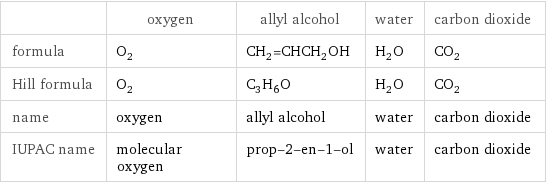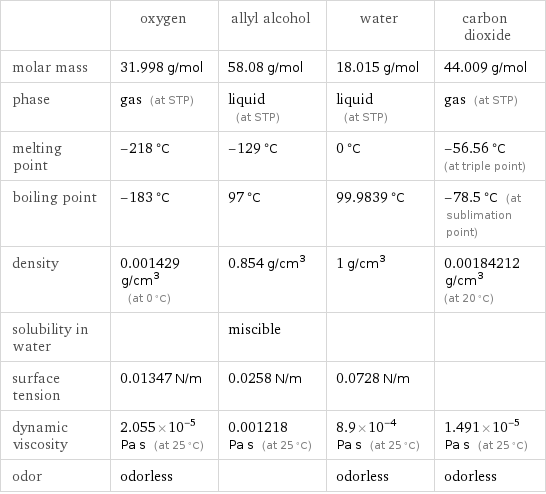Input interpretation

O_2 oxygen + CH_2=CHCH_2OH allyl alcohol ⟶ H_2O water + CO_2 carbon dioxide
Balanced equation

Balance the chemical equation algebraically: O_2 + CH_2=CHCH_2OH ⟶ H_2O + CO_2 Add stoichiometric coefficients, c_i, to the reactants and products: c_1 O_2 + c_2 CH_2=CHCH_2OH ⟶ c_3 H_2O + c_4 CO_2 Set the number of atoms in the reactants equal to the number of atoms in the products for O, C and H: O: | 2 c_1 + c_2 = c_3 + 2 c_4 C: | 3 c_2 = c_4 H: | 6 c_2 = 2 c_3 Since the coefficients are relative quantities and underdetermined, choose a coefficient to set arbitrarily. To keep the coefficients small, the arbitrary value is ordinarily one. For instance, set c_2 = 1 and solve the system of equations for the remaining coefficients: c_1 = 4 c_2 = 1 c_3 = 3 c_4 = 3 Substitute the coefficients into the chemical reaction to obtain the balanced equation: Answer: | | 4 O_2 + CH_2=CHCH_2OH ⟶ 3 H_2O + 3 CO_2
Structures

+ ⟶ +
Names

oxygen + allyl alcohol ⟶ water + carbon dioxide
Equilibrium constant
![Construct the equilibrium constant, K, expression for: O_2 + CH_2=CHCH_2OH ⟶ H_2O + CO_2 Plan: • Balance the chemical equation. • Determine the stoichiometric numbers. • Assemble the activity expression for each chemical species. • Use the activity expressions to build the equilibrium constant expression. Write the balanced chemical equation: 4 O_2 + CH_2=CHCH_2OH ⟶ 3 H_2O + 3 CO_2 Assign stoichiometric numbers, ν_i, using the stoichiometric coefficients, c_i, from the balanced chemical equation in the following manner: ν_i = -c_i for reactants and ν_i = c_i for products: chemical species | c_i | ν_i O_2 | 4 | -4 CH_2=CHCH_2OH | 1 | -1 H_2O | 3 | 3 CO_2 | 3 | 3 Assemble the activity expressions accounting for the state of matter and ν_i: chemical species | c_i | ν_i | activity expression O_2 | 4 | -4 | ([O2])^(-4) CH_2=CHCH_2OH | 1 | -1 | ([CH2=CHCH2OH])^(-1) H_2O | 3 | 3 | ([H2O])^3 CO_2 | 3 | 3 | ([CO2])^3 The equilibrium constant symbol in the concentration basis is: K_c Mulitply the activity expressions to arrive at the K_c expression: Answer: | | K_c = ([O2])^(-4) ([CH2=CHCH2OH])^(-1) ([H2O])^3 ([CO2])^3 = (([H2O])^3 ([CO2])^3)/(([O2])^4 [CH2=CHCH2OH])](../image_source/ceca1fb4712dc4e13b87439e4a4ee13b.png)
Construct the equilibrium constant, K, expression for: O_2 + CH_2=CHCH_2OH ⟶ H_2O + CO_2 Plan: • Balance the chemical equation. • Determine the stoichiometric numbers. • Assemble the activity expression for each chemical species. • Use the activity expressions to build the equilibrium constant expression. Write the balanced chemical equation: 4 O_2 + CH_2=CHCH_2OH ⟶ 3 H_2O + 3 CO_2 Assign stoichiometric numbers, ν_i, using the stoichiometric coefficients, c_i, from the balanced chemical equation in the following manner: ν_i = -c_i for reactants and ν_i = c_i for products: chemical species | c_i | ν_i O_2 | 4 | -4 CH_2=CHCH_2OH | 1 | -1 H_2O | 3 | 3 CO_2 | 3 | 3 Assemble the activity expressions accounting for the state of matter and ν_i: chemical species | c_i | ν_i | activity expression O_2 | 4 | -4 | ([O2])^(-4) CH_2=CHCH_2OH | 1 | -1 | ([CH2=CHCH2OH])^(-1) H_2O | 3 | 3 | ([H2O])^3 CO_2 | 3 | 3 | ([CO2])^3 The equilibrium constant symbol in the concentration basis is: K_c Mulitply the activity expressions to arrive at the K_c expression: Answer: | | K_c = ([O2])^(-4) ([CH2=CHCH2OH])^(-1) ([H2O])^3 ([CO2])^3 = (([H2O])^3 ([CO2])^3)/(([O2])^4 [CH2=CHCH2OH])
Rate of reaction
![Construct the rate of reaction expression for: O_2 + CH_2=CHCH_2OH ⟶ H_2O + CO_2 Plan: • Balance the chemical equation. • Determine the stoichiometric numbers. • Assemble the rate term for each chemical species. • Write the rate of reaction expression. Write the balanced chemical equation: 4 O_2 + CH_2=CHCH_2OH ⟶ 3 H_2O + 3 CO_2 Assign stoichiometric numbers, ν_i, using the stoichiometric coefficients, c_i, from the balanced chemical equation in the following manner: ν_i = -c_i for reactants and ν_i = c_i for products: chemical species | c_i | ν_i O_2 | 4 | -4 CH_2=CHCH_2OH | 1 | -1 H_2O | 3 | 3 CO_2 | 3 | 3 The rate term for each chemical species, B_i, is 1/ν_i(Δ[B_i])/(Δt) where [B_i] is the amount concentration and t is time: chemical species | c_i | ν_i | rate term O_2 | 4 | -4 | -1/4 (Δ[O2])/(Δt) CH_2=CHCH_2OH | 1 | -1 | -(Δ[CH2=CHCH2OH])/(Δt) H_2O | 3 | 3 | 1/3 (Δ[H2O])/(Δt) CO_2 | 3 | 3 | 1/3 (Δ[CO2])/(Δt) (for infinitesimal rate of change, replace Δ with d) Set the rate terms equal to each other to arrive at the rate expression: Answer: | | rate = -1/4 (Δ[O2])/(Δt) = -(Δ[CH2=CHCH2OH])/(Δt) = 1/3 (Δ[H2O])/(Δt) = 1/3 (Δ[CO2])/(Δt) (assuming constant volume and no accumulation of intermediates or side products)](../image_source/ac8e01ce7ec16a974277a4a2434c6b13.png)
Construct the rate of reaction expression for: O_2 + CH_2=CHCH_2OH ⟶ H_2O + CO_2 Plan: • Balance the chemical equation. • Determine the stoichiometric numbers. • Assemble the rate term for each chemical species. • Write the rate of reaction expression. Write the balanced chemical equation: 4 O_2 + CH_2=CHCH_2OH ⟶ 3 H_2O + 3 CO_2 Assign stoichiometric numbers, ν_i, using the stoichiometric coefficients, c_i, from the balanced chemical equation in the following manner: ν_i = -c_i for reactants and ν_i = c_i for products: chemical species | c_i | ν_i O_2 | 4 | -4 CH_2=CHCH_2OH | 1 | -1 H_2O | 3 | 3 CO_2 | 3 | 3 The rate term for each chemical species, B_i, is 1/ν_i(Δ[B_i])/(Δt) where [B_i] is the amount concentration and t is time: chemical species | c_i | ν_i | rate term O_2 | 4 | -4 | -1/4 (Δ[O2])/(Δt) CH_2=CHCH_2OH | 1 | -1 | -(Δ[CH2=CHCH2OH])/(Δt) H_2O | 3 | 3 | 1/3 (Δ[H2O])/(Δt) CO_2 | 3 | 3 | 1/3 (Δ[CO2])/(Δt) (for infinitesimal rate of change, replace Δ with d) Set the rate terms equal to each other to arrive at the rate expression: Answer: | | rate = -1/4 (Δ[O2])/(Δt) = -(Δ[CH2=CHCH2OH])/(Δt) = 1/3 (Δ[H2O])/(Δt) = 1/3 (Δ[CO2])/(Δt) (assuming constant volume and no accumulation of intermediates or side products)
Chemical names and formulas

| oxygen | allyl alcohol | water | carbon dioxide formula | O_2 | CH_2=CHCH_2OH | H_2O | CO_2 Hill formula | O_2 | C_3H_6O | H_2O | CO_2 name | oxygen | allyl alcohol | water | carbon dioxide IUPAC name | molecular oxygen | prop-2-en-1-ol | water | carbon dioxide
Substance properties

| oxygen | allyl alcohol | water | carbon dioxide molar mass | 31.998 g/mol | 58.08 g/mol | 18.015 g/mol | 44.009 g/mol phase | gas (at STP) | liquid (at STP) | liquid (at STP) | gas (at STP) melting point | -218 °C | -129 °C | 0 °C | -56.56 °C (at triple point) boiling point | -183 °C | 97 °C | 99.9839 °C | -78.5 °C (at sublimation point) density | 0.001429 g/cm^3 (at 0 °C) | 0.854 g/cm^3 | 1 g/cm^3 | 0.00184212 g/cm^3 (at 20 °C) solubility in water | | miscible | | surface tension | 0.01347 N/m | 0.0258 N/m | 0.0728 N/m | dynamic viscosity | 2.055×10^-5 Pa s (at 25 °C) | 0.001218 Pa s (at 25 °C) | 8.9×10^-4 Pa s (at 25 °C) | 1.491×10^-5 Pa s (at 25 °C) odor | odorless | | odorless | odorless
Units
